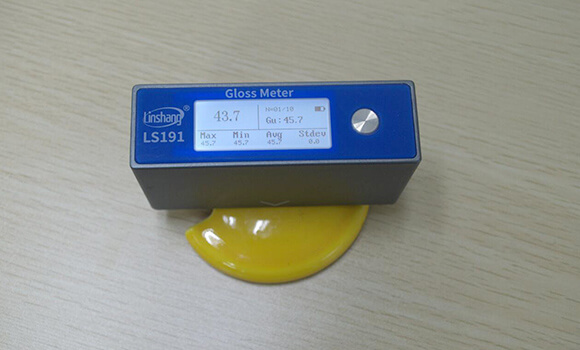Glossiness Measurement and Gloss Meter Standard
1. Why do you want to measure the surface gloss of an object?
When a product needs to give a beautiful impression, gloss is an important attribute and generally needs to be measured by a gloss meter. This attribute has been valued in many products, such as mobile phones, tableware, pipes, cars, etc.
The gloss also depends on the surface roughness, texture and spectral characteristics of the object. For a non-porous surface, the intensity of the surface reflection determines the quality of the surface gloss. For surface porous media, the volume scattering of the surface should be considered. Although the human eye is a good tool for surface gloss detection, it is not enough in the industrial field, so automated equipment on the production line is favored, such as a gloss meter. Therefore, offline and online gloss meters are frequently used in routine inspections of product surfaces. It should be noted that gloss has a great impact on the party. The definition of gloss is effective in the entire electromagnetic spectrum. In a sense, the gloss meter uses the reflection of the terahertz radiation of the object to measure.
2. Gloss meter measurement standard
In fact, the detection of the glossiness has already been standardized. The measurement principle is very simple and it can be extended to offline or online gloss measurement. The white light source of the laser beam collimated by the lens illuminates the surface that is not smooth or polished. The reflected light is collected by another lens and sent to the photodetector. According to the standard, the object surface must be flat. A standard reference surface is highly polished black glass with a refractive index of 1.567. The standard will provide 100 specular gloss units at all angles of incidence, but in principle this definition has no gloss on the line. Typical gloss meters use incident angles of 20 °, 45 °, 60 °, 75 ° and 85 °. Low and high angles correspond to smooth and matte surfaces, respectively.
Gloss measurement standards require that the object surface must be flat and constrained. In commercial glossmeters, the probe area of incident light is usually relatively large. Therefore, problems arise in detecting tiny and curved surfaces. Most gloss meters require contact measurement with objects (super calendered paper in paper mills requires a non-contact scanning system for online detection), so fragile surfaces are not within the detection range of these detectors.
3. Linshang LS191 gloss meter
(1) Application range of LS191 gloss meter
The LS191 gloss meter is a high-precision gloss meter independently developed by Linshang Technology, which has independent intellectual property rights and conforms to the Chinese national standard GB / T9754. The instrument adopts a 60 ° universal angle to meet the requirements of the first-class working machine in the JJG696 standard.
The test range of the LS191 gloss meter is 0-200GU. It is especially suitable for the gloss measurement of the surface of medium and low gloss types of paints, inks, coatings, plastics, leather, ceramics, bamboo products, marble materials and other materials.
(2) How to use the gloss meterLS191?
First press the power button to turn on the instrument. After the calibration is completed, the test interface is entered. The display interface can display the real-time value, the maximum value, the minimum value, the average value, the standard deviation value, the current recorded value and the number of measurements and statistics. After the test, close the instrument to the base of the standard board and it will automatically shut down in 15 seconds.
The gloss meter LS191 does not require buttons during testing, as long as the instrument is placed on the material to be tested, the test data is displayed immediately. Press the power button, you can record the current test data and the gloss meter will automatically calculate the maximum value, minimum value, average value and standard deviation value. The smaller the standard deviation value, the more uniform the material surface gloss.
